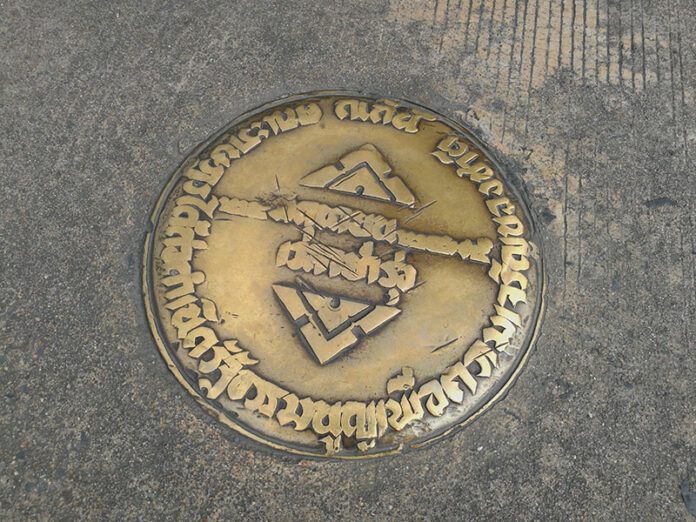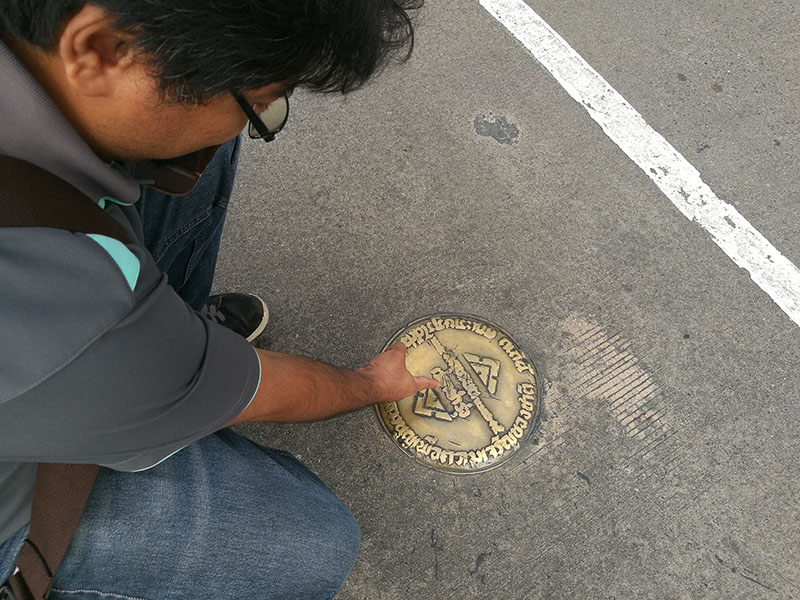
BANGKOK — Just a few days into the new year, Chotisak Onsoong was relieved to learn one of the nation’s most important – if inglorious – symbols of democracy was still intact despite a call for its destruction.
Two months earlier, an open threat had been made to obliterate the worn brass nub which sits in the road at the Royal Plaza and is dedicated to the civilians and officers known as “the Promoters” behind the bloodless 1932 coup which ended absolute monarchy. Eighty-five years later, some revanchist ultra-royalists say that was a mistake.
In a message posted online, Chotisak, a pro-democracy activist, said he needed to see it for himself. On Monday, as soon as he could return to Bangkok from the flooded south, he visited and took photographs of the marker, two weeks after its threatened date of destruction had passed.
Visiting the plaque Monday, Chotisak noted several gouges in it he believes were the work of vandals.
The original threat was made Oct. 31 by Thepmontri Limpaphayorm, a royalist and history buff.
“Announcement to owner: If you do not dig it up by December 30, 2016, my friends and I will consider it as lacking ownership and will remove or incapacitate it. If you want to preserve it, dig it up quickly. Thank you,” he wrote.
He didn’t reply to a message sent asking why he wanted the plaque removed and why he didn’t make good on his statement.
But the threat itself, according to experts including historian Charnvit Kasetsiri, is proof the debate over which political system is best suited for Thailand still isn’t over – at least for some.
“In a way this is just a small historical plaque, but its meaning is vast,” said Charnvit, a former rector of Thammasat University, which was founded by one of the Promoters. “It’s a symbol of new power that is democratic, that overthrew absolute monarchy in 1932. That’s why those who still believe in the old system hate and threaten to destroy this plaque.”
In “Thailand: A Short History,” late Cornell University historian David K. Wyatt concisely summarized the revolt:
“[W]hile the king was vacationing at the sea-side, a small group of middle-level officials, numbering slightly more than one hundred, carried out a lightning swift coup d’etat at dawn on 24 June 1932. With only a handful of troops at their command, they bluffed and immobilized other military units in the capital, rounded up the chief officials of the government, and sent a delegation calling upon the king, in the name of the People’s party, to agree to submit to a constitution…”
Faded words on the marker itself carry an even more terse message through time:
“On this spot, the Promoters gave birth to the constitution for the benefit of the nation. June 24, 1932. Dawn.”

The plaque, made of brass and about 30 centimeters across can be found embedded in the asphalt road that is the Royal Plaza, less than 10 meters from the equestrian statue depicting King Rama V. It’s where the revolt took place on June 24, 1932, where a declaration condemning absolute monarchy was read.
Another historian, Thamrongsak Petchlertanan, said the plaque is a reminder that democracy was fought for and not granted by the traditional elites.
“It reminds people that democracy in accordance with international principles must be fought for and built by [people] themselves,” Thamrongsak said.
Though Thepmontri didn’t reply to a reporter’s inquiry, he did pose a question some months ago shedding some light on his thinking.
“Someone asked for my opinion. The person said it’s been about 85 years since the 1932 revolt by the Promoters. We’ve had many prime ministers and ministers who were corrupt. Should we remove the plaque or not? Some say this plaque is a symbol of disgrace for the democratic system. What do you think?” he wrote on Oct. 31, following the original post that caused the stir.
In another message, he suggested more practical considerations:
“It’s useless to keep it. Cars have run over it until [the letters] have become blurred. It should be kept at parliament or anywhere else.”
But then he went back to removing it, saying there are two ways to handle it: dig it out or bury it. One user writing under the pen name Man Koerd-Samart suggested that he should pour acid on the brass plaque.
To those who want self-rule, it’s an enduring symbol. Pro-democracy activist Sombat Boonngam-anong has sold hundreds of wall clocks styled after the plaque to earn a living since the junta froze his bank accounts in response to this call for its ouster. He charges 2,900 baht a pop and said he chose the design for its symbolic value.
“Thepmontri has a problem with the Promoters. He thinks that the revolt in 1932 shouldn’t have occurred and is evil. That it led to elections and corrupt politicians,” said Sombat, adding that these sentiments are being expressed because the backlash against and enmity for politicians are at a zenith.
Should it Stay or Should it Go?
After eight decades, the plaque’s words have faded. Cars continue to run over it. With the threat of vandalism, some have considered ways to preserve it.
Chotisak believes the original plaque should be left alone but cordoned off and turned into a proper monument. Thamrongsak and Charnvit agree it shouldn’t be relocated.
“Moving it to a museum would destroy the historical potency of the plaque,” said Thamrongsak, who said a yellow traffic line should be added to steer cars around it. “But we can only do that when the country is democratic.”
The historian said he has a real fear the authorities under the present military regime would turn a blind eye to vandalism.
Charnvit pointed out that a replica already exists at Thammasat University in front of the Main Conference Hall. Charnvit is also not inclined to replace it with a replica to safeguard the original. “If a replica is placed there it will lack the potency. But even if someone destroys it, they cannot really destroy it,” Charnvit said, because it has long been in the minds of Thais who support democracy.
Sinsawat Yodbangtoey, former manager of the Pridi Banomyong Institute, which is named after the man who led the revolt’s civilian faction, was less attached.
“This plaque is just a symbol of a beginning. It’s neither holy nor has any supernatural powers,” he said. Sinsawat suggested the plaque be left there unaltered with a life-size replica kept somewhere safe.
As for Sombat, he thinks nothing should be done except showing some respect by not allowing cars to run over it.
“Just accord it with some respect it deserves.” June 14, the day of the revolt, was in fact Thailand’s National Day from 1939 to 1959. It was later changed during a surge of royalism to Dec. 5, the birthday of the late King Bhumibol.
Totem of Democracy
Charnvit sees greater symbolism to the peg than just history. In Thai, it is referred to as mued (pin), suggesting something is being pinned to the plaza.
“Might there be a supernatural connotation associated with it?” Charnvit said.
He added that there’s a natural confrontation at work by its placement, so close to the statue of King Rama V, which is revered by royalists as a symbol of absolute monarchy.
“If you believe in superstition, you may believe that the plaque is pinning the power of the monarchy. Thus it must be removed,” he said.
















































